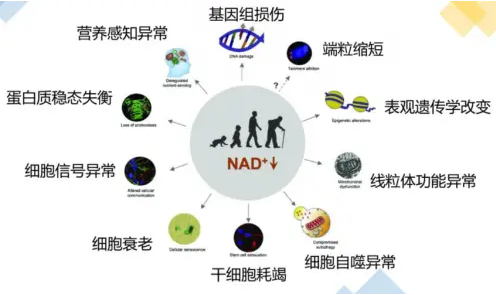What is NAD+?
NAD+, or nicotinamide adenine dinucleotide, is a key metabolite and coenzyme present in every cell of the human body. This small molecule works under the catalysis of more than 300 enzymes and participates in multiple physiological processes such as metabolism, redox reactions, DNA maintenance and repair, gene stability, and epigenetic regulation.
The magical function of NAD+
One of the functions of NAD+ is to promote the production of bioenergy. By participating in cellular respiration, NAD+ can generate ATP, directly replenish cellular energy, and enhance cellular function, which is crucial for the normal operation of the whole body system. In addition, NAD+ also has the function of repairing genes. As a substrate of the DNA repair enzyme PARP, it helps repair damaged DNA, reduce the probability of cell mutation, and prevent the occurrence of aging-related diseases such as cancer.

NAD+ and Anti-Aging
More and more studies are focusing on the relationship between NAD+ and anti-aging. NAD+ not only activates bioenergy production, but also activates all longevity proteins, which makes it play a more important role in anti-aging. Longevity proteins are a class of proteins that can delay the aging process, and activating these proteins helps keep the body healthy and young.
However, as we age, the amount of NAD+ in our bodies drops dramatically, and by the age of 30 it may even drop to half of its original level. This decline is associated with a variety of aging-related diseases, including cognitive decline, inflammation, cancer, metabolic diseases, sarcopenia, neurodegenerative diseases, etc. Therefore, it is necessary to supplement NAD+.
Precursor of NAD+
Because NAD+ molecules are large, people cannot directly ingest them into cells orally. One way to solve this problem is to ingest NAD+ precursors with smaller molecular weights, which are then metabolized into NAD+ by the body. Niacin, tryptophan, niacinamide, NR, and β-niacinamide mononucleotide (NMN) are the five precursors of NAD+. Among these five precursors, NR has been proven to be the most effective precursor for synthesizing NAD+. Its molecules are smaller, can enter cells directly, and act on cells throughout the body, which has strong clinical research support.